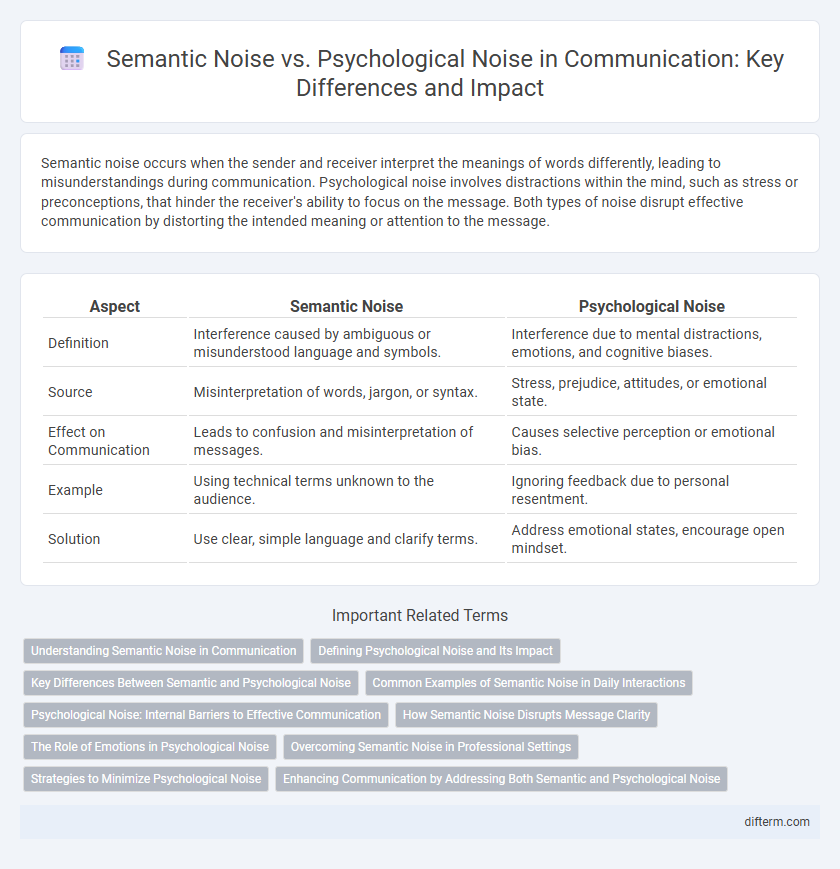Semantic noise occurs when the sender and receiver interpret the meanings of words differently, leading to misunderstandings during communication. Psychological noise involves distractions within the mind, such as stress or preconceptions, that hinder the receiver's ability to focus on the message. Both types of noise disrupt effective communication by distorting the intended meaning or attention to the message.
Table of Comparison
| Aspect | Semantic Noise | Psychological Noise |
|---|---|---|
| Definition | Interference caused by ambiguous or misunderstood language and symbols. | Interference due to mental distractions, emotions, and cognitive biases. |
| Source | Misinterpretation of words, jargon, or syntax. | Stress, prejudice, attitudes, or emotional state. |
| Effect on Communication | Leads to confusion and misinterpretation of messages. | Causes selective perception or emotional bias. |
| Example | Using technical terms unknown to the audience. | Ignoring feedback due to personal resentment. |
| Solution | Use clear, simple language and clarify terms. | Address emotional states, encourage open mindset. |
Understanding Semantic Noise in Communication
Semantic noise in communication arises when the sender and receiver interpret words or symbols differently due to language barriers, jargon, or ambiguous meanings. This type of noise distorts the intended message, causing misunderstanding or misinterpretation that impedes effective communication. Unlike psychological noise, which stems from internal distractions like emotions or biases, semantic noise directly affects the clarity and accuracy of the transmitted information.
Defining Psychological Noise and Its Impact
Psychological noise refers to internal factors such as emotions, attitudes, and mental states that disrupt the clarity and effectiveness of communication. It impacts message interpretation by causing misunderstandings, selective perception, or biased responses, which hinder accurate information exchange. Recognizing psychological noise is essential for improving active listening and fostering empathetic communication in personal and professional interactions.
Key Differences Between Semantic and Psychological Noise
Semantic noise arises from ambiguous language, jargon, or differing interpretations of words, causing misunderstandings in communication. Psychological noise stems from internal factors like emotions, biases, or mental distractions that distort the receiver's ability to process messages effectively. The key difference lies in semantic noise being rooted in language barriers, while psychological noise originates from cognitive and emotional interference.
Common Examples of Semantic Noise in Daily Interactions
Semantic noise frequently occurs in daily interactions when individuals use jargon, technical terms, or ambiguous language that the receiver misinterprets or does not understand. Common examples include misunderstandings caused by slang, idiomatic expressions, or words with multiple meanings that confuse the intended message. These barriers disrupt effective communication by distorting the sender's message within the semantic system.
Psychological Noise: Internal Barriers to Effective Communication
Psychological noise refers to internal barriers such as stress, biases, and preconceived notions that distort message interpretation and hinder effective communication. These mental distractions create misunderstandings by filtering or altering the sender's intended meaning within the receiver's mind. Managing psychological noise involves cultivating self-awareness and emotional regulation to enhance clarity and empathy in interactions.
How Semantic Noise Disrupts Message Clarity
Semantic noise disrupts message clarity by causing misunderstandings due to differences in language, vocabulary, and interpretations between sender and receiver. When words or phrases have ambiguous or multiple meanings, the intended message becomes confusing, leading to ineffective communication. This distortion hinders accurate information exchange and reduces overall message comprehension.
The Role of Emotions in Psychological Noise
Emotions in psychological noise significantly distort message interpretation by triggering biased perceptions and selective attention during communication. Unlike semantic noise, which involves misinterpretation of language or symbols, psychological noise stems from internal emotional states such as stress, anger, or anxiety, causing misunderstandings despite clear verbal content. Understanding the emotional impact on receivers enhances communication effectiveness by addressing affective barriers that interfere with message clarity.
Overcoming Semantic Noise in Professional Settings
Overcoming semantic noise in professional settings requires clear language, precise terminology, and active feedback to ensure message clarity. Using standardized vocabulary and avoiding jargon reduces misunderstandings that arise from ambiguous semantics. Training in effective communication techniques and encouraging questions further minimizes semantic barriers, enhancing workplace collaboration.
Strategies to Minimize Psychological Noise
Psychological noise, stemming from internal factors like stress, biases, or emotional states, can distort message interpretation and hinder effective communication. Strategies to minimize psychological noise include practicing active listening, fostering empathy by understanding the communicator's perspective, and creating a supportive environment that reduces anxiety and distractions. Encouraging mindfulness and self-awareness also helps individuals manage personal emotions, allowing clearer focus on the message and reducing cognitive interference.
Enhancing Communication by Addressing Both Semantic and Psychological Noise
Semantic noise occurs when misunderstandings arise from language barriers, ambiguous words, or complex jargon, hindering message clarity. Psychological noise includes mental distractions such as stress, bias, or emotional states that distort message interpretation. Enhancing communication requires addressing semantic noise through clear, precise language and reducing psychological noise by fostering an open, empathetic environment that minimizes emotional interference.
Semantic noise vs Psychological noise Infographic

 difterm.com
difterm.com